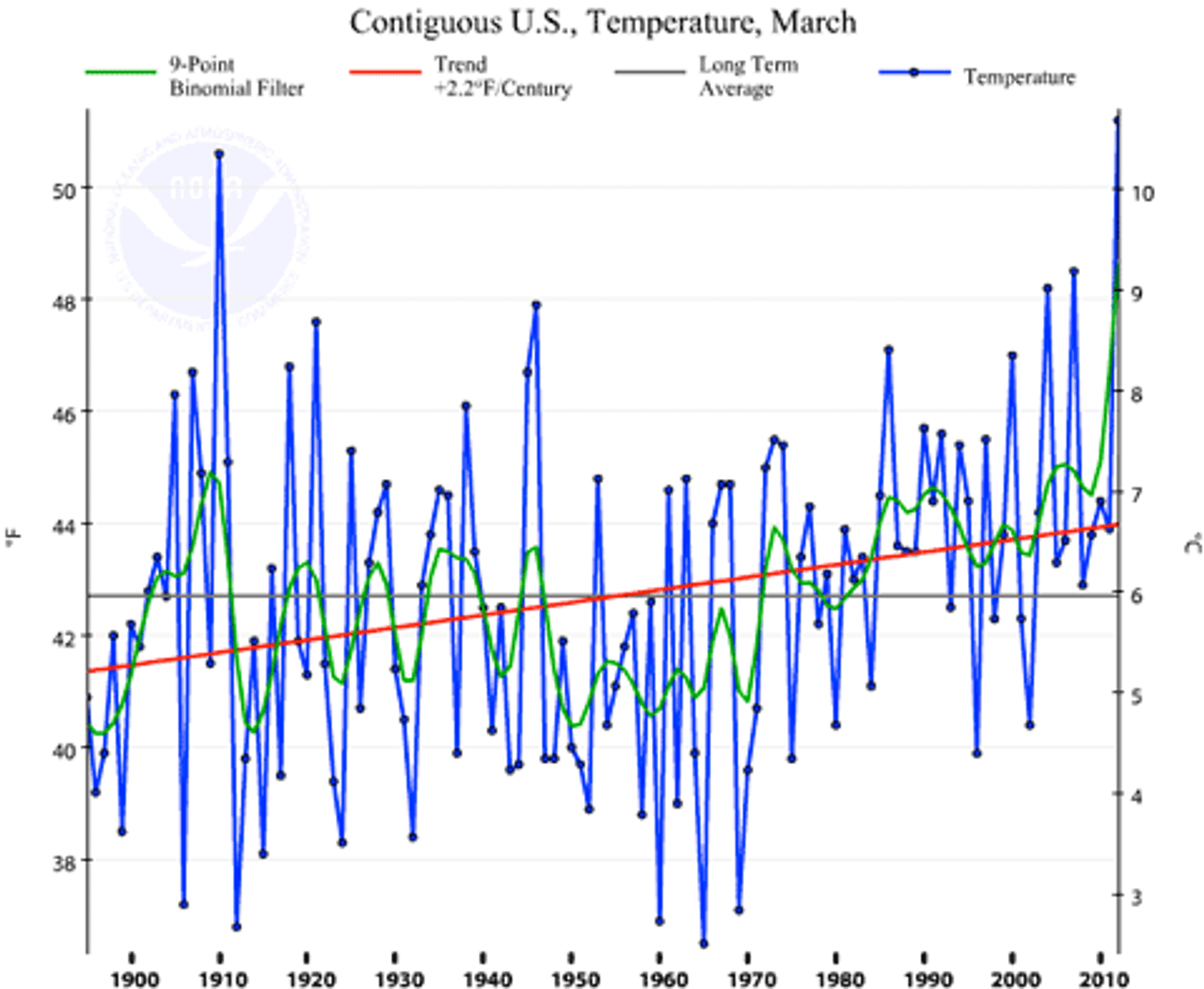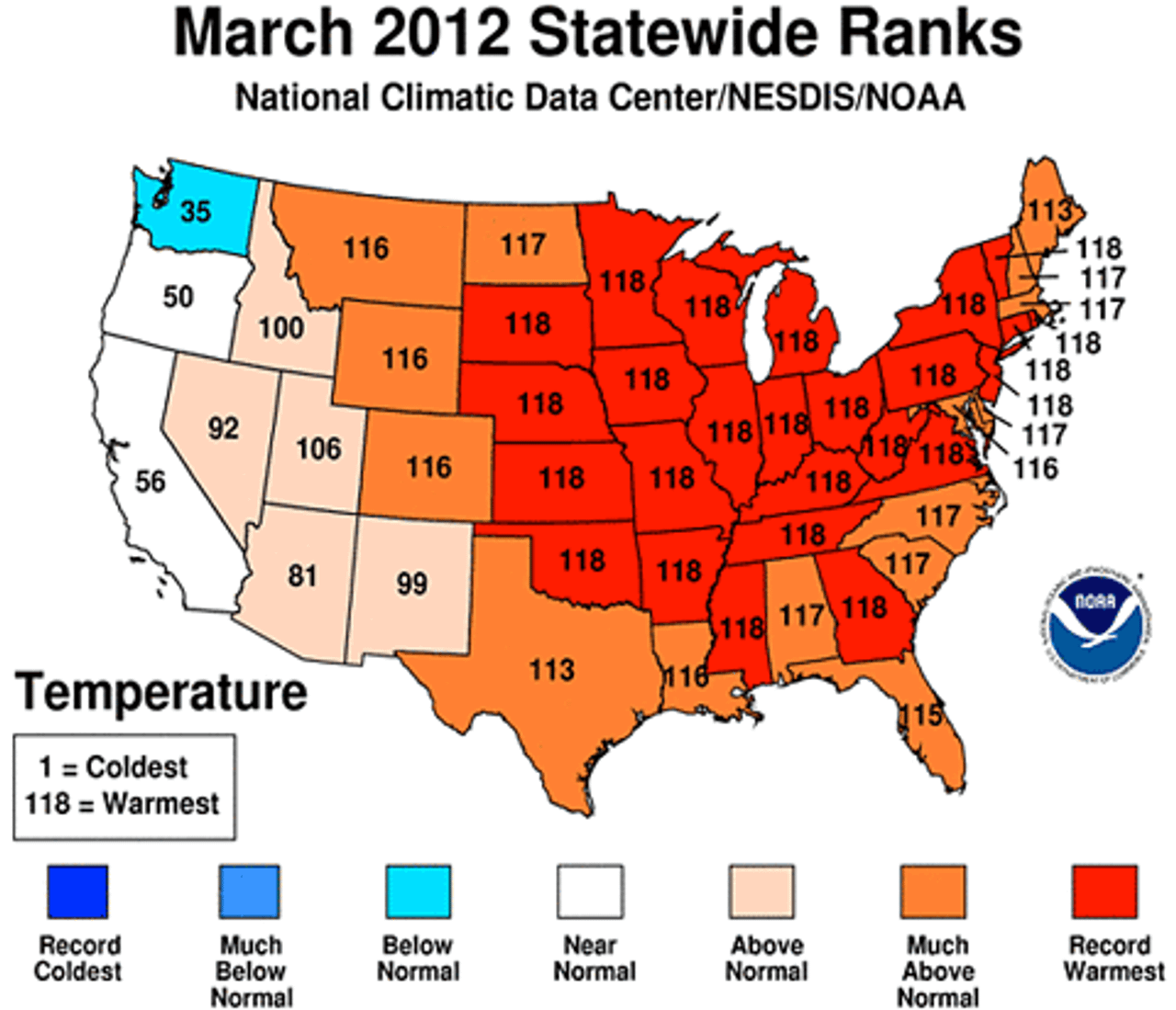An unusual heat wave east of the Rocky Mountains has made March 2012 the warmest March on record for the contiguous United States, 0.3 degrees Celsius (0.5 degrees Fahrenheit) above the previous 1910 record, and 4.8 °C (8.6 °F) above the 20th century average.
 Following the second-warmest summer and the fourth-warmest winter on record (dating back to 1895), this March’s record heat wave made the year from April 2011 to April 2012 the warmest 12-month period on record for the contiguous United States. In March, both Chicago and Milwaukee broke their previous records by nearly 3 °C (5 °F). This heat wave included 7,775 daytime and 7,517 nighttime record highs, including 21 instances of nighttime highs surpassing previous daytime records.
Following the second-warmest summer and the fourth-warmest winter on record (dating back to 1895), this March’s record heat wave made the year from April 2011 to April 2012 the warmest 12-month period on record for the contiguous United States. In March, both Chicago and Milwaukee broke their previous records by nearly 3 °C (5 °F). This heat wave included 7,775 daytime and 7,517 nighttime record highs, including 21 instances of nighttime highs surpassing previous daytime records.
 In addition, on March 2-3 a series of tornadoes across the south-central portion of the country caused at least 40 deaths and more than $1.5 billion in damage. At the same time, record snowfalls in Anchorage, Alaska have totaled as much as 3.4 meters (more than 11 feet) by early April, causing roof collapses and temporarily forcing many residents to leave and enter their homes through second-story windows.
In addition, on March 2-3 a series of tornadoes across the south-central portion of the country caused at least 40 deaths and more than $1.5 billion in damage. At the same time, record snowfalls in Anchorage, Alaska have totaled as much as 3.4 meters (more than 11 feet) by early April, causing roof collapses and temporarily forcing many residents to leave and enter their homes through second-story windows.
These cases of extreme weather occur in the context of the 2003 heat wave in Western Europe that claimed more than 35,000 lives, the 2010 summer heat wave in Russia (the warmest on record in 500 years) that caused hundreds of wildfires and destroyed a third of the country’s grain harvest, devastating floods in Pakistan in July 2010 affecting some 20 million people and causing nearly 2,000 deaths and $4 billion in damage, and the 2010-2011 floods in Queensland and Victoria, Australia that caused an estimated $3 billion in damage.
Climatologists attribute many of the above events to la Niña. The el Niño/la Niña cycle is part of the oscillating pattern of warming and cooling of the Pacific Ocean surface that occurs approximately every five years. The warm ocean surface temperature of el Niño causes higher surface air pressure in the western Pacific, while the cool ocean temperature of la Niña causes the reciprocal lower pressure arm of the cycle.
The precise mechanisms of these cyclical oscillations of temperature in the Pacific Ocean are still being determined, and their effects vary widely by region, heat waves and droughts in some areas and cold-snaps and floods in others.
The consensus of climate scientists as to the relationship between occurrences of extreme weather and global warming is that, while global warming does not specifically cause any event, it does increase the probability that any given climate cycle will generate extreme weather.
Climate scientist Dim Coumou, from the Potsdam Institute for Climate Impact Research in Germany, uses “loaded dice” to illustrate the effect of global warming on weather. According to probability, one would expect a six-sided die, when rolled, to show a five on average once in every six rolls (any of the six faces showing is equally probable). A loaded die, one in which weight is distributed unevenly, will give a particular face more often than should be possible according to probability.
Through global warming, humans have created a loaded die for weather probability. As an illustration, in normal conditions an extreme weather event might occur on average in only one of six climate cycles. However, the higher average atmospheric temperature from global warming means the chances of getting extreme weather from each cycle would be higher than one-in-six, and the overall chance of extreme weather increases as global temperature rises.
While the implications of climate research remain largely toned-down or kept out of the popular media in the United States and other countries, insurance companies are becoming keenly aware of the problems posed by the increased frequency of extreme weather. In 2011, weather-related losses for insurance companies amounted to $35 billion in the United States and more than $100 billion worldwide.
Cynthia McHale, who manages insurance for the nonprofit environmental group Ceres, was quoted by the Washington Post as saying, “If we continue on this path, extreme weather is certain to cause more homes and businesses to be uninsurable in the private insurance market, leaving the costs to taxpayers or individuals.” In the current environment of crisis, austerity, and social counterrevolution, this can only mean the increasing impoverishment of the world’s poor and working class by increasingly frequent natural disasters.
The political establishment is well aware of the potential effects of climate change on social cohesion and the international status quo. A 2007 report by the Center for Strategic and International Studies (CSIS) anticipates that the relatively mild temperature increase of 1.3 °C by 2040 will result in, “heightened internal and cross-border tensions caused by large-scale migrations, conflicts sparked by resource scarcity, particularly in the weak and failing states of Africa; increased disease proliferation, which will have economic consequences; and some geopolitical reordering as nations adjust to shifts in resources and prevalence of disease.”
However, the recent spate of extreme weather and even the scenario laid out for the 1.3 °C scenario are actually very mild in terms of possible effects of climate change. The CSIS anticipates that an increase of as little as 2.6 °C by 2040 will mean that “nations around the world will be overwhelmed by the scale of change and the pernicious challenges, such as pandemic disease… Armed conflicts between nations over resources, such as the Nile and its tributaries, are likely and nuclear war is possible… In this scenario, climate change provokes a permanent shift in the relationship of humankind to nature.”
Alarmingly, it seems increasingly likely that even these dire projections may turn out to be rosy. This is because recent research indicates that in the near future climate change will cease to proceed on a linear scale. The world is currently about 1 °C above pre-industrial temperatures, with an anticipated increase of 0.2 °C per decade at the current levels of greenhouse gases in the atmosphere. Loss of Arctic ice may contribute an additional 0.3 °C to global warming. Taken together, at current rates of warming and increases in atmospheric greenhouse gases, a 2 °C rise in global temperatures above pre-industrial levels seems increasingly inevitable.
The 2 °C mark is critical, as this is the point at which scientists anticipate climate feedback-loops will kick in, accelerating climate change and making it irreversible. At this temperature, melting of the tundra in northern regions is anticipated to release massive amounts of the greenhouse gas methane into the atmosphere, rapidly amplifying the greenhouse effect. At the 3 °C mark, devastation of the world’s rainforests and oceans will transform these ecosystems into net emitters (as opposed to their current role as sinks) of greenhouse gases. In such a scenario it is likely that global temperatures could reach as high as 6 °C above pre-industrial levels.
Estimates by some scientists are for an increase in global temperature of 6 °C by the year 2100. The CSIS anticipates that in such a situation, “[t]he collapse and chaos associated with extreme climate change would destabilise virtually every aspect of modern life.” It is anticipated that at the six-degree mark, the greater part of the Earth would be uninhabitable for humans, with sea levels rising by 25 meters, 90 percent of species facing extinction, and the world human population falling by 80 percent.
The repeated failure of climate conferences to yield any significant deal among the various capitalist rivals reveals the complete impotence of capitalism to resolve a dire threat to the survival of the human species. The only likely method under which greenhouse gas emissions will be reduced by the various capitalist nation-states is through the massive devastation of a world war, leading to a reversion to pre-industrial conditions—in other words, a variant of the six-degree calamity.
A solution to this global problem is impossible within the nation-state system or through the profit motive. As in the case of the other great threats to mankind—imperialist war, economic collapse, attacks on democratic rights—the environmental crisis means that more than at any previous point in history, the fate of mankind is in the hands of the world proletariat and can only be insured in a progressive fashion through the construction of international socialism and the planned world economy.
